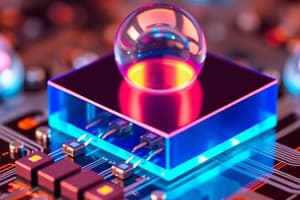Podcast
Questions and Answers
What is the primary characteristic of quantum silicone compared to traditional silicon?
What is the primary characteristic of quantum silicone compared to traditional silicon?
- Quantum silicone shows quantum mechanical properties at the nanoscale. (correct)
- Quantum silicone is less efficient than traditional silicon.
- Quantum silicone is solely used for structural applications.
- Quantum silicone exhibits classical electronic behaviour.
Which phenomenon allows electrons to pass through energy barriers in quantum silicone?
Which phenomenon allows electrons to pass through energy barriers in quantum silicone?
- Quantum confinement
- Quantum tunneling (correct)
- Quantum entanglement
- Quantum superposition
How do quantum dots in quantum silicone affect light characteristics?
How do quantum dots in quantum silicone affect light characteristics?
- They exhibit continuous energy levels.
- They emit no light at all.
- They completely absorb all light.
- They show quantized energy levels affecting light emission and absorption. (correct)
What potential application does quantum silicone have in computing?
What potential application does quantum silicone have in computing?
What advantage does quantum confinement in silicon offer for solar cells?
What advantage does quantum confinement in silicon offer for solar cells?
Flashcards
Quantum Confinement
Quantum Confinement
Occurs when silicon structures are very small (nanoscale), trapping electrons in a small space, creating specific energy levels.
Quantum Tunneling
Quantum Tunneling
Electrons can pass through energy barriers, a quantum effect, changing how quantum silicone works electrically and optically.
Quantum Dots
Quantum Dots
Tiny silicon crystals (nanoscale) with specific energy levels affecting light absorption/emission compared to normal silicon.
Quantum Computing applications of quantum silicone
Quantum Computing applications of quantum silicone
Signup and view all the flashcards
Quantum Well Structure
Quantum Well Structure
Signup and view all the flashcards
Study Notes
Introduction to Quantum Silicone
- Quantum silicone refers to silicon-based materials exhibiting quantum mechanical properties.
- These properties are typically observed at the nanoscale, where quantum effects become significant.
- The study of quantum silicone investigates the unique electronic, optical, and mechanical behaviour of these materials arising from quantum phenomena rather than classical behaviour.
- This is distinct from traditional silicon used in electronics, which operates in a classical regime.
Key Properties of Quantum Silicon
- Quantum Confinement: Quantum confinement occurs when the dimensions of a silicon structure are reduced to the nanoscale. This confines the electrons within a smaller space, leading to discrete energy levels.
- Quantum Tunneling: Electrons can tunnel through energy barriers, a quantum mechanical phenomenon, which can modify the electrical and optical properties of quantum silicone structures.
- Quantum Dots: Quantum dots, nanoscale silicon crystals, exhibit quantized energy levels; this affects their light emission and absorption characteristics relative to bulk material.
- Quantum Wires: Likewise, quantum wires, one-dimensional nanoscale silicon structures, exhibit similar behaviour with quantized energy levels impacting their electrical transport and optical properties.
- Quantum Well Structures: Creating layered structures of silicon with differing bandgaps can create quantum wells, allowing for tailored electronic properties. This could lead to novel optical or electronic functionalities.
Applications of Quantum Silicone
- Quantum Computing: Quantum silicone structures could potentially be used as components in quantum computers designed with novel qubit implementations. Quantum bits (qubits) are basic units of information in quantum information processing, and silicone-based quantum dots or wires are of interest for qubit functionality.
- Quantum Sensing: Quantum silicone structures could be used in highly sensitive sensors due to their unique response to external stimuli at a quantum level.
- Solar Cells: Quantum confinement in nanoscale silicon could enhance light absorption and improve solar cell efficiency.
- Light Emitting Diodes (LEDs): Quantum dots of silicon might lead to novel LED designs with improved colour tunability or increased efficiency.
- Novel Electronics: Quantum silicone may enable the creation of high-performance transistors and other electronic devices with enhanced electrical and optical properties surpassing classical silicon-based counterparts.
Challenges in Quantum Silicone
- Fabrication: Precise fabrication of nanoscale silicon structures with required uniformity and control is technically challenging. This remains a key hurdle in developing the field.
- Scalability: Large-scale production of quantum silicone devices is not yet efficient or well-established.
- Quantum Mechanical Modelling: Thorough and accurate simulations of systems at the nanoscale are crucial to predict and design specific properties, but these can be computationally intensive.
- Understanding Defects: Defects in nanoscale structures can impact the performance of quantum silicium, requiring detailed investigation and mitigation strategies.
Research Directions
- Development of new fabrication techniques for nanostructured silicon with precise control over size and shape.
- Studying the interplay of quantum phenomena and the material's physical properties (e.g., interaction between quantum dots).
- Investigating novel quantum silicone-based devices using simulations and experimentations.
- Optimization of properties, such as quantum confinement and tunneling processes, to create materials with tailored characteristics in various applications.
- Exploring integration with other nanomaterials to create complex nanoarchitectures that enhance device functionalities.
Studying That Suits You
Use AI to generate personalized quizzes and flashcards to suit your learning preferences.



